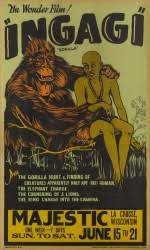
“Ingagi” was released in 1930 and was directed by William Campbell. A synopsis of the film would be of little use since the entire movie is fake. Labeled as a documentary it is instead a pre-code mockumentary exploitation film. It is supposed to be film of an expedition into the Congo jungle to investigate and record a tribe that worships gorillas. The expedition eventually finds the tribe and is present when a “virgin” is sacrificed to the gorilla. In essence given to the gorilla as a sex slave. The gorilla takes the virgin and runs away with her. The expedition follows the gorilla to try to save the woman.
Most of the film is footage stolen from other films. The rest is footage filmed at the Los Angeles Zoo. The film boasts two stars and a narrator that is supposed to also be one of the explorers. Most of the stars of the film are either actors or fake. One of the stars/explorers is Sir Hubert Winstead. There is no such person. The others are actors. Even the gorilla is fake and was played by Charles Gemora. Gemora is a make-up artist and is known for playing lots of gorillas and aliens. The title of the film “Ingagi” is supposedly the Kinyarwanda word for gorilla. Whether it is or not I don’t know.
Questions about the authenticity of the film began when one of the “natives” in the film was recognized as an actress from Central Casting. Plus the fact that the “gorilla”, Gemora, sued the producers of the film, “Congo Films” for his unpaid salary. When the American Society of Mammalologists tried to check the credentials of the British explorers, Sir Hubert Winstead and Captain Daniel Swayne, with the British Embassy is was discovered that neither man existed. Some of the stolen footage was from an actual silent ethnographic film made in 1915 by big game huntress Lady Grace Mackenzie. When this information was discovered her son Byron Mackenzie sued the film’s producers. When theaters tried to stop showing the film a judge ruled that a fake film could not invalidate a legitimate contract. As long as customers were willing to shell out enough money to purchase tickets that equaled the $2,500 a week that the film was grossing, the theaters had to continue showing the film until the contract ran out.
The new species of venomous reptile, the "Tortadillo," that is shown in one scene was actually a leopard tortoise with various do-dads stuck onto it. The "pygmies" shown in the film were actually black children between the ages of five and ten from the Los Angeles area. There is also the suggestion that some of the native women were white actresses in blackface.
The fact that the film was believed to be lost is also not true. The Federal Trade Commission issued a statement prohibiting any further distribution unless the filmmakers acknowledged their product as being a work of fiction. Since this never happened the film fell into obscurity. It was just never released to video or shown on television. It has been in The Library of Congress all this time. The film has finally been released in January 2021 by “Kino” and “Something Weird Video”.
Even though just about everything about the movie was fake, and is horribly racist and sexist, it still grossed 4 million dollars. In reality the parts of the movie that are from Lady Mackenzie’s nickelodeon film “Heart of Africa” were real shots of her hunting in Africa. You can even see her in some of the shots, especially the lion hunt. So a lot of the fake movie is actually real, but not in the context submitted by the “Ingagi” film makers.
Other than the big game hunt and the actual jungle footage the film itself is not that impressive. The idea of bestiality may be titillating and one reason why the film did so well at the box office, but it’s still basically crap. In the 30’s jungle movies were all the rage thanks to Lady Mackenzie, Teddy Roosevelt and, well, Tarzan. Add to that gorillas were fairly new to the viewing public, not a lot of zoos had them. In addition the Scopes Monkey Trail was still fresh in people’s minds. What’s more fascinating than to delve into the forbidden idea that we are the next generation from apes? And are we close enough that interspecies procreation is possible?
In 1940 a film called “Son of Ingagi” was made. It has nothing to do with “Ingagi”. Supposedly the success of the movie was the reason RKO Radio Pictures invested in the film “King Kong” 1933. RKO owned some of the theatres Ingagi was shown in.

